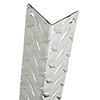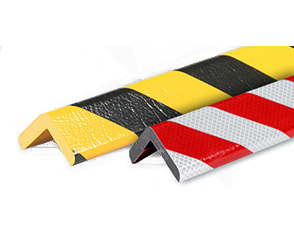Brass
Click below for pertinent facts and informational links for the materials that our corner guards are made from.
Our brass corner guards are formed from Muntz brass. These products are solid brass and not a brass coating over a metal substrate. When this material is scratched it will still be a brass finish that is shown.
- Brass corner guards are available in both a Satin #4 (Brushed) Finish as well as a Mirror #8 (Polished) Finish.
- We offer both finishes in material thickness of .040’’ and .063’’.
- Muntz Brass does not have a lifetime coating on it will require occasional maintenance or polishing.
- Muntz Brass provides for a very upscale look in high end offices or the hospitality industry.
More information on Muntz Brass:
From Wikipedia: https://en.wikipedia.org/wiki/Muntz_metal
Muntz metal is a form of alpha-beta brass with about 60% copper, 40% zinc and a trace of iron. It is named after George Fredrick Muntz, a metal-roller of Birmingham, England, who commercialized the alloy following his patent of 1832.[1]
Known both as Muntz Metal and Yellow Metal,[2] the alloy must be worked hot and is used today for corrosion resistant machine parts. Alpha-beta (also called duplex) metals contain both the α and β phases. The α phase refers to a crystal structure that is face-centered cubic, while the β phase is body-centered cubic.
Its original application was as a replacement for copper sheathing on the bottom of boats, as it maintained the anti-fouling abilities of the pure copper at around two thirds of the price. It became the material of choice for this application and Muntz made his fortune. It was found that copper would gradually leach from the alloy in sea water, poisoning any organism that attempted to attach itself to a hull sheathed in the metal. Thus, it was also used to sheathe the piles of piers in tropical seas, as a protection against teredo shipworms, and in locomotive tubes. After successful experimentation with the sheathing Muntz also took out a patent for bolts of the same composition. These also proved a success as they not only were cheaper but also very strong and lasted longer.
A notable use of Muntz Metal was in the hull of the Cutty Sark.[3]
What is Muntz metal used for?
Muntz metal, also called Yellow Metal, variety of the alloy brass consisting of 60 percent copper and 40 percent zinc, named after the English businessman George F. Muntz, who patented it in 1832. Muntz metal must be worked hot. It is used to make machine parts that require resistance to corrosion.
What does Muntz mean?
Definition of Muntz metal. : an alloy of copper and zinc that contains 60 percent of copper, can be rolled hot, and is used especially for sheathing and bolts.
Which is better bronze or brass?
Higher malleability than zinc or copper. ... Brass is any alloy of copper and zinc. Bronze is a metal alloy consisting primarily of copper, usually with tin as the main additive, but sometimes with other elements such as phosphorus, manganese, aluminum, or silicon.
Does brass turn green?
Why Brass, Bronze and Copper Turn Green
That means that if there's no iron, there's no rust. But both are types of oxides. When you see that green layer on these metals (usually called patina or verdigris) it's because of a chemical reaction. ... Brass is an alloy that's usually made up of 67% copper and 33% zinc.
Is bronze or brass more expensive?
Bronze is more expensive than brass. Zinc is cheaper than copper. The greater the zinc content the less the cost, and certain bronze alloys are four times more expensive than certain brass alloys. Thus bronze has the perception of greater value than brass.
Is Brass magnetic?
When we mix zinc and copper to form the alloy brass, we also end up with a non-magnetic compound. So, brass is not magnetic. Like aluminum, copper, and zinc, brass does interact with moving magnets. In the video below a brass plate on a pendulum will move rapidly in the absence of a magnet.












